2024 Lake Vermilion Loon Camera Live Stream
________________________________________________________________________
Loons abandon nest and their 4th egg after eagle scares – July 14, 2024
By Noel Sederstrom, VLA Volunteer

The VLA’s Live LoonCam on July 15 (photo by Bill Michaelson)
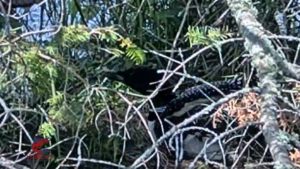
Loon sees eagle in flight and begins diving for the water the afternoon of July 12.
Lake Vermilion, Minn. (VLA) – After being spooked by bald eagles overflying their area, the pair of mating loons we’ve been following this spring and summer abandoned their nest on a tiny rocky island on Lake Vermilion. It happened the evening of Saturday, July 13.
When the more-responsible loon parent swam away from the nest for the last time—without looking back—the pair’s 4th egg was left defenseless in the nest. It meant giving up on everything both of them had been working so hard on for more than two months.
Three hours later a gang of three furry thieves made their way into the nest and ransacked it.
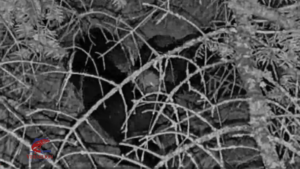
Two furry thieves invade the nest and roll around with the loon’s last egg. (Live LoonCam image captured in Infrared light)
The pair of loons has been attempting since early May to bring one or two chicks into the world. At first, the loons chose a bushy area in a shallow bay near lily pads for a nesting site. But high water drove them off that location after misfortune with their first two eggs.
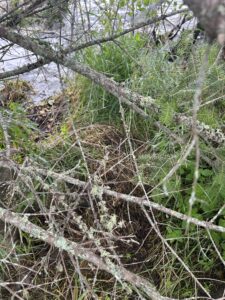
Empty loon’s nest on July 15, showing the steep drop to the water behind it. (photo by Bill Michaelson)
The second nest location they chose was much higher. It brought different challenges. Most of all, it was easy for the marauders to roll the eggs out of the nest and into the water.
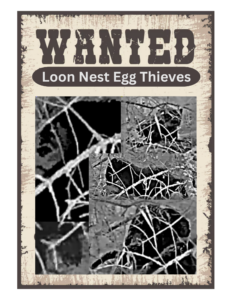
If only the loons had their own sheriff who could put up a Wanted Poster for these suspects!
Mink have been tormenting loons in this part of the northern Minnesota Arrowhead. Were these mink? Or young otters?
Thanks to the VLA’s Live LoonCam with its Infrared light capability, we obtained good images of the suspects that will allow true experts to offer opinions.
Bill Michaelson of our team made an in-person visual inspection of the nesting site the day after it was abandoned. He reported seeing no signs of eggshells or any other remnants of the loons’ nesting time that could help us answer why the loons were not more successful at this island location.
The pair had actually used this exact spot last summer. Both last year and this year, they once again ignored a protective man-made loon nest “raft” tethered nearby. Not far from this nesting site, a different loon pair actually chose to use a man-made floating loon nesting platform this summer. It’s believed to be the first time any loon pair used one of the platforms here on Lake Vermilion.
The Vermilion Lake Association expresses sincere appreciation to Access Broadband of Virginia, Minnesota, for all the upload power this spring and summer! And to our Live LoonCam site host, who wishes to remain anonymous. We couldn’t have done any of this without them!
———————————————————————————————————
________________________________________________________________________
Three attackers swarm unprotected nest, steal loons’ 3rd egg – July 10, 2024
By Noel Sederstrom, VLA Volunteer
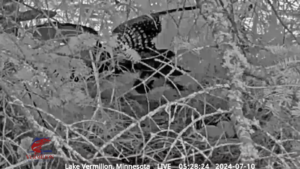
5:28 a.m.: a frightened Mom Loon takes flight, leaving two eggs unprotected in the nest.
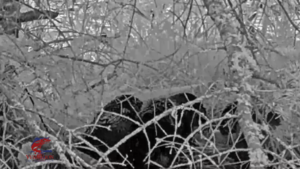
5:41 a.m.: three attackers sneak up from the lake on the mainland side of the loons’ island.
One attacker quickly went down to stand guard on the mainland side of the island entryway. The other went down to the lake side to watch for the loon’s return. Meantime, the third attempted to bite through the eggshells.
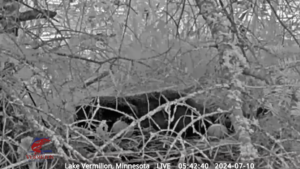
5:42 a.m.: Main suspect cannot bite through eggshell, rolls egg toward the water.
One loon egg remained—and then the lakeside “guard” ambled back through the nest and sniffed at it, but chose to leave it alone and instead join the others in the water with their stolen egg. The damage has been done.
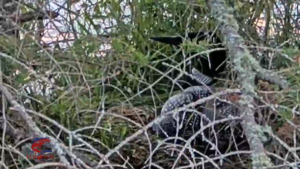
5:47 a.m.: Loon back on nest after scuffle in water with attacker, now protecting only one egg.
So far this summer, either attackers or high water is blamed for the loss of three of the four eggs laid and nurtured by this loon mating pair. Can they succeed with this fourth egg and bring a chick into the world? Is it even viable? Good questions, with no clear answers right now.
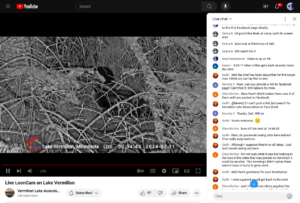
Experts and newcomers offer their theories on what they see on the VLA’s YouTube channel page.
If you care about our loons on Lake Vermilion, and would like to be part of the loon-watching and commenting community, our YouTube channel is the place to go!
________________________________________________________________________
Rising above the floodwaters, the loons build a new nest and start over – July 4, 2024
By Noel Sederstrom, VLA Volunteer
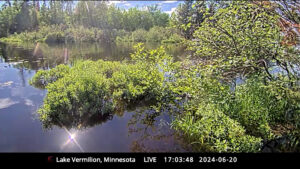
After heavy rain, the loons’ original nest completely disappeared under 12″ of water.
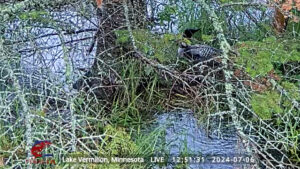
The loons have settled into a new routine at this familiar nest site–they used the rocky island in 2023.
With our Live LoonCam swiveled around and trained on their new nest site, we have visual proof that Mom Loon has laid two new eggs, her third and fourth of the summer. Bill Michaelson led his marine team in re-positioning our Axis camera and its companion parabolic mic on the 4th of July after we got word the loons had reestablished a nest on top of a small rocky island not far from their previous spot.
One big unknown is the timing of what we are all witnessing. Nancy Watkins was one of those wondering about this very good question after we shared the news on our Facebook page. Our best estimate on when the third egg was laid is June 29, based on an analysis of the sounds we heard from the LoonCam system before it was adjusted. If that’s correct, our hatch target range might be July 25-29.
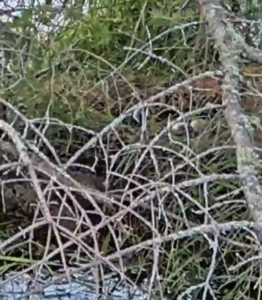
When the loon went for a swim, we could clearly see two new eggs in the nest.
Chicks start to swim within hours of hatching, and get constant care from their parents. They’re fed and famously carried around on the parent’s back, but also encouraged to do everything on their own as fast as they can muster it.
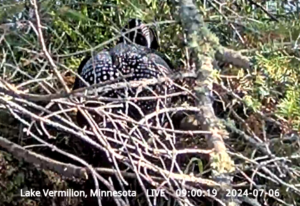
Mom Loon inspects her two eggs after coming back from a swim on July 6, 2024.
By the time cold weather comes, the little ones have to be able to fly south and survive on their own, so the clock is really ticking for this little loon family.
In the meantime, the loon parents are now on “high alert” for threats. On the afternoon of July 5, our loon watchers on the VLA’s YouTube channel suspected an eagle was scoping out the area, driving our loon off the nest for a time into the nearby waters, screaming back at the intruder.
You can join in the conversation any time on our YouTube channel, or catch up on what has happened this spring and summer right here on the Vermilion Lake Association’s website. Scroll down for previous reports.
________________________________________________________________________
The Loons’ Darkest Day – June 14, 2024
By Noel Sederstrom, VLA Volunteer
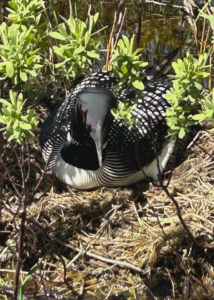
Mom Loon on her nest (photo by Bill Michaelson)
Lake Vermilion, Minn. (VLA) – In the pitch black of midnight, a truly terrible day began unfolding for the loons we’ve been monitoring this May and June on Lake Vermilion. Starting with fear and terror, turning to joy, then confusion that led to despair and fury— Mom and Dad Loon lived through every bit of it before June 14 came to an end.
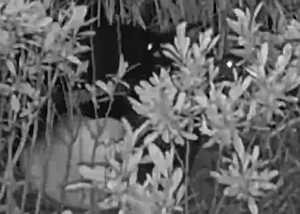
Mom Loon fights back after mink attacks early June 14
As the mink attacked in the total darkness, the loon tried to spear it with her beak, taking stabs in the dark over and over. Then the mink bit the loon and held on, and they began furiously thrashing around the nest, with the egg bouncing back and forth. The loon was blind in the dark, but our camera’s Infrared imaging lets us see what happened. The loon prevailed in the fight and was able to scare it off with screams for help from her mate. She remained on high alert all night.
As dawn arrived, Mom Loon stood up to roll the egg, a necessary step every so often during incubation
to promote healthy metabolism of a developing chick. A little after 6 a.m., she discovered the egg had
cracked open and immediately began preparing for the little one.
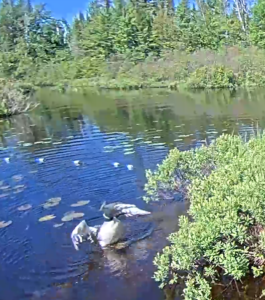
Loon tries to intimidate creature hiding in bushes
We can surmise that there never was a developing chick in the egg, that it wasn’t viable, and that when the egg cracked open, the fluid inside just seeped into the nest area and was gone. For an egg to protect a developing chick, it must be kept warm. The rising cold waters of Lake Vermilion back in late May could have interfered with everything. But it’s really all deductive guesswork on our part.
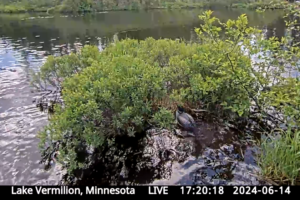
Mom Loon takes one last look at her nest
As their real-life nightmare tapered down toward sunset, Mom Loon ventured back to her nest, searching one last time. She looks around at the place she’s been spending so much of her time the past month, the nest she crafted, inspecting every twig and piece of debris. Then she finally moves on. Will she try again this summer? We wait to see.
The emotional drama is featured in the video below this story. To see it, just click on the window.
________________________________________________________________________
Something tragic happened while our Live LoonCam was “down” – June 2, 2024
By Noel Sederstrom, VLA Volunteer
Lake Vermilion, Minn. (VLA) – When the live image of the loon’s nest froze early May 24, those of us on the Vermilion Lake Association’s Live LoonCam team immediately blamed the big swimmer with the sharp buck teeth. We had just witnessed a huge beaver swimming silently underwater through the shot shortly before it happened. After dark, our camera detects heat from birds and animals with Infrared light to show us what’s happening, as you can see in this image.
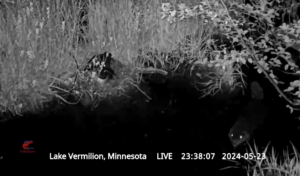
Beaver swims past loon’s nest heading toward the mainland.
 Our marine team leader—Bill Michaelson—was able to put a new Ethernet cable in place a week later, and we’re using a new strategy to keep the cable away from the loons. That brought big smiles when we were back online June 1.
Our marine team leader—Bill Michaelson—was able to put a new Ethernet cable in place a week later, and we’re using a new strategy to keep the cable away from the loons. That brought big smiles when we were back online June 1.
A day later, however, we realized something tragic had happened in the week we were unable to monitor the loon pair guarding their nest. There was only one egg in the nest.
Did a predator get the other egg? We had witnessed a savage mink attack days before and the loon had fought off two of them acting in tandem.  Or did the rising water claim one of the eggs? We’ll never know.
Or did the rising water claim one of the eggs? We’ll never know.
“It will be easier for the loon parents to feed, protect and care for the one remaining chick,” pointed out Debra, one of our YouTube loon chat experts. While that’s true, many of us were really excited at the prospect of seeing two chicks from this nest. Two little ones emerged from the loon nest we were monitoring two years ago at a different location down the Lake Vermilion shoreline, and it was such a delight to watch them interact and grow.
The loon parents have redoubled their efforts this week to protect the one egg that remains. All of us are eagerly looking forward to next weekend. By our calculations, a chick could emerge from that egg as early as Saturday, June 8.
________________________________________________________________________
Muskrat Scare, Beaver Glare, then darkness – May 24, 2024
by Noel Sederstrom, VLA Volunteer
Lake Vermilion, Minn. (VLA) – With two eggs in their nest, our loons are on “high alert” for danger—especially after dark. There was an incident just before 11 p.m. Thursday that freaked out our loon. It was the first of two encounters within an hour on the Night Watch.
Without sound and without warning, a muskrat swam underwater to the side of the bank and surfaced in the pitch dark ready to attack. The loon sprang into a ferocious stance and scared it off, then called out in panic to her partner for help. The call for help would go unanswered.
Some 42 minutes later, our Infrared Axis camera picked up motion underwater coming in from the bay of Lake Vermilion. Silently, a huge beaver glided by without paying any attention to the loon, still sitting vigilant. The beaver was on a different kind of mission.
Not long afterwards, 15 minutes later, our Live LoonCam went dark. Some of us monitoring the loon’s activities had heard grunting and chewing noises nearby off-camera the night before. We’re pretty sure when the time comes to replace the Ethernet cable, when a new one arrives in a few days, the VLA marine team will find damage underwater. And we have a prime suspect with big teeth.
________________________________________________________________________
Rising Waters Threaten Loon Nest – May 21, 2024
By Noel Sederstrom, VLA Volunteer
Lake Vermilion, Minn. (VLA) – The rising waters of Lake Vermilion on Tuesday created a threat for “our” loons protecting two eggs on their nest. It became a day of hunting for building material, bolstering the nest, and nudging the eggs away from the water’s edge.
________________________________________________________________________
Mink Attack Loon Protecting Nest and Two Eggs – May 20, 2024
By Noel Sederstrom, VLA Volunteer
Lake Vermilion, Minn. (VLA) – The loon protecting two eggs on a nest along the Lake Vermilion shoreline was attacked Monday night by a pair of marauders. They appeared to be mink.
There was no apparent damage to the eggs. After the first animal came at the loon from the water, and met a ferocious response, a second came sneaking up on the nest from the brush and attempted to bite through one of the egg’s shell.
Before the second attacker could try a second time, the loon had leaped back up from the water and scared it off. It all happened in pitch black darkness; it’s obvious the loon was guessing where the attackers were.
The Infrared light on our Axis camera captures the whole thing. You might notice the loons built their nest right next to our Ethernet cable, which had been laid by Bill Michaelson and his marine team weeks ago, before the loons arrived from the south.
Debra, one of the knowledgeable loon watchers who monitors things on our YouTube channel, says this is the second apparent mink attack at “our” loon nest, and that there has been at least one other mink attack on a loon nest in Minnesota’s Arrowhead region.
We’re grateful for our internet partner’s support for our project, Access Broadband of Virginia.
________________________________________________________________________
Mom Loon lays second egg – May 15, 2024
By Noel Sederstrom, VLA Volunteer
Lake Vermilion, Minn. (VLA) – The loon watchers on our YouTube channel were really excited Wednesday afternoon about 4 o’clock–Mom Loon laid a second egg in the nest we’re monitoring.
It’s pretty rare that we can witness this. Most of the time, a bird in the wild is hidden in brush or otherwise out of view. Or such a thing happens in the darkness of night.
The loon’s tremendous exertion goes on for many minutes. After a time, the loon left the nest for a swim, and maybe a snack. Just to “cut to the chase” a screengrab of the nest with two eggs has been edited onto the end of the video clip.
Her first egg was laid on Monday, May 13. Loon experts say the average incubation period is 27 days, with the typical range between 26-29 days. So mark your calendar for June 9! Usually the second chick would hatch within 24 hours of the first one.
Our thanks to Access Broadband for the internet power to bring you these images!
________________________________________________________________________
Loons begin taking turns sitting on the nest – May 15, 2024
By Noel Sederstrom, VLA Volunteer
Lake Vermilion, Minn. (VLA) – It’s Wednesday, two days after Mom Loon laid her first egg, and suddenly there’s a new urgency about the family schedule. Mom and Dad Loon have begun taking turns on the nest.
When this happens, there’s often quite a conversation that goes along with it. Impossible though it may be to figure out what each cooing noise means, maybe you can imagine what they’re saying.
Here is a clip from mid-afternoon when Dad Loon left the nest and Mom took over. Note that at this point in the day… there was one egg in the nest.
________________________________________________________________________
Loons build nest in unexpected place, Mom lays an egg – May 14, 2024
By Noel Sederstrom, VLA Volunteer

Lake Vermilion, Minn. (VLA) – After snooping around a small island where she had nested before, we got two surprises from Mom Loon the day after Mother’s Day. She had a change of heart, and crafted this year’s nest in a clump of reeds about ten feet closer to shore. Then, demonstrating the urgency of it all, she laid her first egg of the season.

The head of our marine team, Bill Michaelson, made his way there the next day and quietly swung our Live LoonCam around so we could get the new nesting site in the image. Mom Loon ignored him, pretending he wasn’t there, and that he didn’t see her—even though he was only a few feet away from her at one point.
While it might be vexing that we guessed wrong on what “our” loons would do, thanks to Bill’s quick work we are in business and have a great vantage point for the spring and summer! Our Axis camera and parabolic mic are pointed right at the nest and we’ll be able to closely monitor their activities.
With that clear view, we can tell you that as of May 14, Mom Loon is protecting one egg in her nest with guard duty help from Dad Loon. They take a break every so often, giving us a good chance to capture a shot inside their nest.
________________________________________________________________________
Loons spend part of Mother’s Day exploring possible nest location – May 12, 2024
By Noel Sederstrom, VLA Volunteer
Two weeks after arriving on Lake Vermilion from the south, “our” Mom and Dad Loon spent part of their Mother’s Day evening not in the water, but exploring a small spot on one of their favorite islands. Mom Loon appeared to be checking out the location for her nest, and there was a lot of soft loon conversation about what they were seeing. We caught the encounter happening just before sunset, and the male was clearly not as interested as she was. Watch and listen.
Thanks again this year to Access Broadband of Virginia, MN, our internet partner.
________________________________________________________________________
It’s Warming Up – and the Loons are Back! – May 4, 2024
by Noel Sederstrom, VLA Volunteer

Lake Vermilion, Minn. (VLA) – The ice went out a few weeks ago—the DNR’s official date was April 13—and it didn’t take long for the loons to migrate north and begin claiming “their” home turf along the Lake Vermilion shoreline.
The Vermilion Lake Association’s Live LoonCam powered up on May 1 at a new location for this spring and summer. It’s along a rocky shore in a small bay that’s a favorite spot for a loon pair that has returned year after year. Our live camera is currently pointed NNW at a small peninsula where they’ve chosen to build a nest in the past. Toward the lower left in the shot you can see a man-made loon platform also available; its cage-like metal archway offers some protection against eagles and other mortal enemies.
The first day the LoonCam was powered up both loons were swimming near it cooing to each other but they stayed out of sight.
Our VLA Team’s plan is to wait for them to settle on a nesting site, then re-point the camera and parabolic mic right at the action. This year we will deploy Infrared light so their movements will be discernible after dark. The IR is in an upper bandwidth that makes it invisible to humans, warm-blooded animals and birds. If it starts attracting too many bugs, we’ll reconsider.
Last summer we watched a different loon pair raise a chick. In fact, the VLA Loon Count reported 156 adults and 29 chicks on Lake Vermilion in 2023, nearly as many as the summer before. Our lake is a stable and supportive environment for the loons! That’s why they come back year after year.
We’re really grateful to Access Broadband of Virginia, MN for providing the WiFi internet service for our Live LoonCam project again this year. Keep up with the antics of the loons all season long on our Facebook page, or subscribe to our YouTube channel so you can comment on what you see.
____________________________________________________________________________________________
2023 Lake Vermilion Loon Camera Live Stream – ARCHIVE
2022 Lake Vermilion Loon Camera Live Stream – ARCHIVE
2021 Lake Vermilion Loon Camera Live Stream – ARCHIVE
____________________________________________________________________________________________
In March, 2021, the Vermilion Lake Association launched a team to design and build a live camera system that could stream a live view of a loon’s nest during the summer months to our website and to YouTube, also creating content for our Facebook friends. Thanks to our members whose annual dues paid for the equipment, and to Access Broadband of Virginia, MN, for the WiFi service that makes this possible. It’s our intent to keep the location of the live LoonCam unidentified to protect the privacy of the loon family and their human neighbors.
For more information on our loon population and loon stewardship, please visit https://www.vermilionlakeassociation.org/other-programs/loon-information/.
